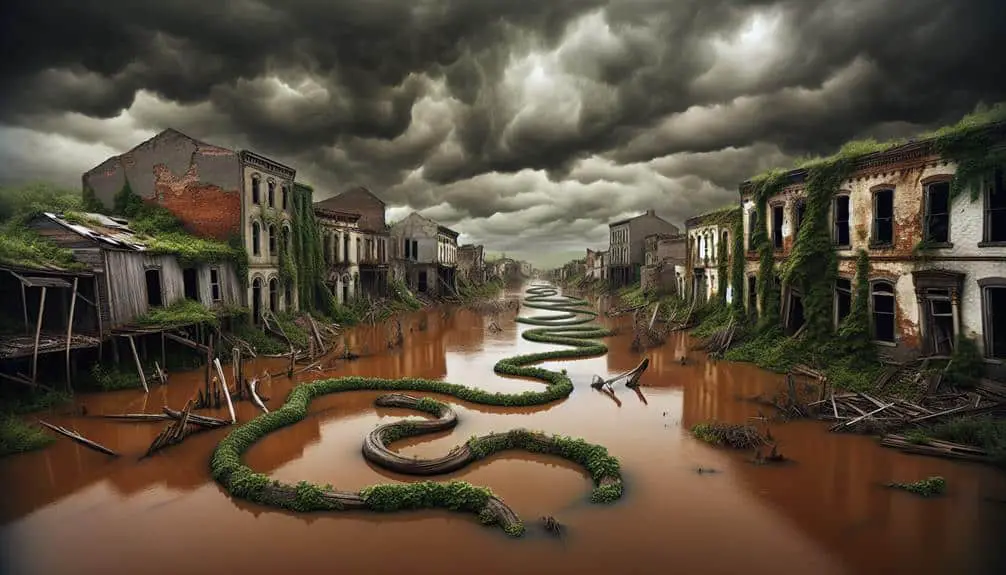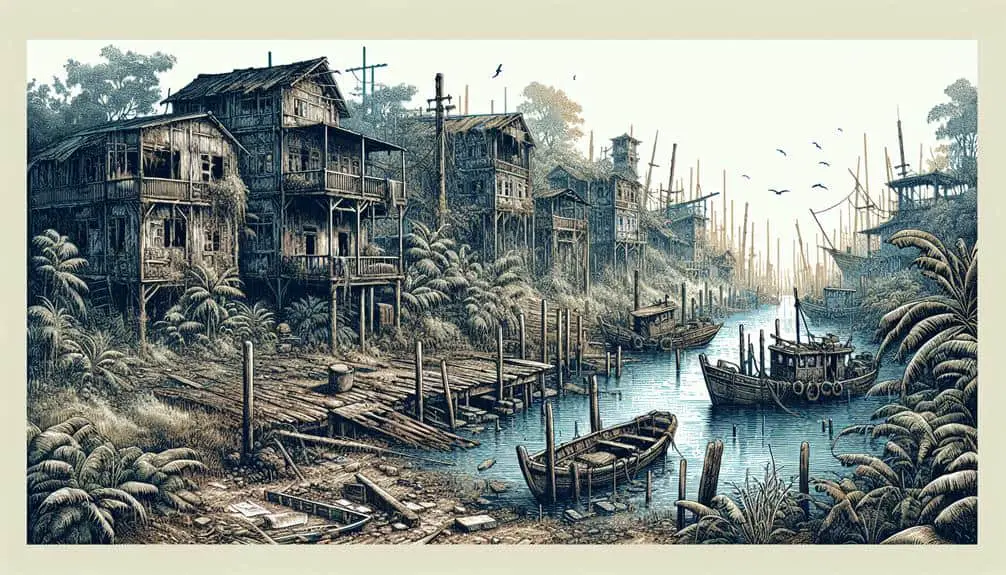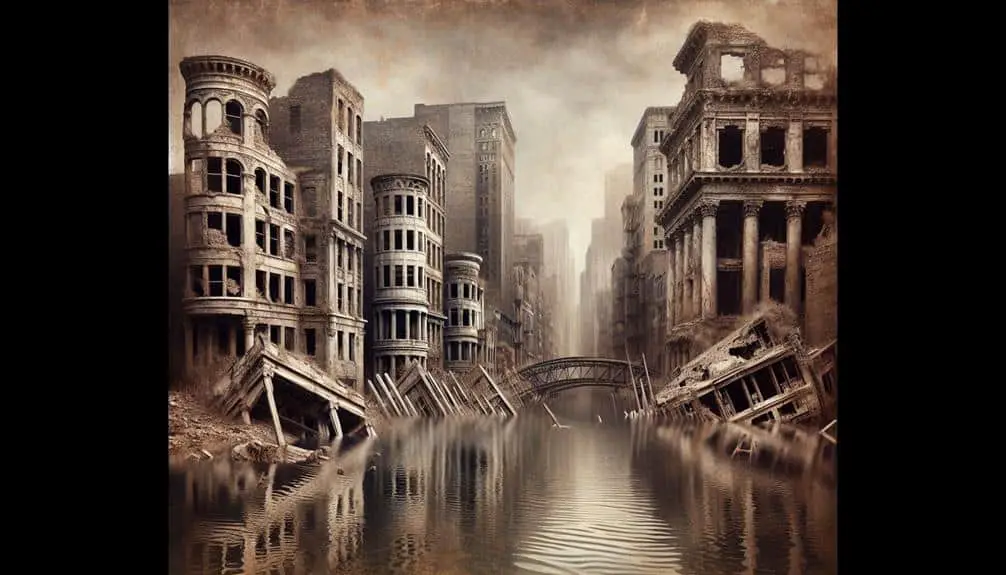Navigate flooded ghost towns along US rivers to discover submerged remnants of historical significance. River dynamics, climate change, and land use affect submersion. Explore eerie beauty, haunting structures, and hidden artifacts in underwater landscapes. Overcome challenges like safety risks, debris, and specialized equipment needs for exploration. Preservation efforts combine historical research and conservation to honor lost communities. Immerse yourself in the depths to uncover the intriguing legacy of sunken settlements.
Key Points
- Understand the hydrological conditions for safe navigation.
- Use specialized equipment like underwater cameras.
- Navigate carefully around dilapidated buildings and debris.
- Balance exploration with historical preservation.
- Respect the underwater ecosystem to minimize disturbances.
Historic Origins of River-Engulfed Towns
The inundation of rivers resulting in the submersion of towns is a phenomenon rooted in the historical development of settlements along waterways. Archaeological discoveries have highlighted the cultural significance of these submerged towns, offering insights into past civilizations and their interactions with the environment. Environmental impact assessments reveal the consequences of settling in flood-prone areas, shedding light on the challenges faced by early settlers and the evolution of urban planning strategies.
These submerged towns serve as time capsules, preserving remnants of past societies and providing valuable information for historical research. The archaeological remnants found in these submerged areas not only enrich our understanding of the past but also underscore the importance of sustainable urban planning practices. By studying these ghost towns, we can learn valuable lessons about adapting to natural environments and mitigating the risks associated with living near water bodies. Understanding the historical origins of river-engulfed towns is essential for developing resilient communities that can withstand the forces of nature while preserving our cultural heritage.
Factors Contributing to Town Submersion
Amidst the historical context of river-adjacent settlements, understanding the key factors that contribute to town submersion is essential for evaluating the risks associated with flood-prone areas. Factors such as environmental impact and urban planning play pivotal roles in the submersion of towns along US rivers.
- River Dynamics: Changes in river flow patterns and sediment deposition can alter the landscape, increasing the risk of flooding.
- Climate Change: Rising sea levels and more frequent extreme weather events can lead to higher water levels and increased flooding in river-adjacent areas.
- Land Use Changes: Poor urban planning decisions, such as building in floodplains or inadequate drainage systems, can exacerbate the impact of flooding.
- Deforestation: Loss of natural vegetation can reduce the land's ability to absorb water, leading to increased runoff and higher flood risks.
- Infrastructure Development: Construction of dams, levees, and other structures can alter natural water flow, affecting the dynamics of flooding in the area.
Understanding these factors is crucial for mitigating the risks associated with town submersion and ensuring sustainable urban development in flood-prone regions.
Notable Flooded Ghost Towns Today
What're the significant characteristics of flooded ghost towns today? When exploring ruins of flooded ghost towns, one encounters a unique blend of historical remnants and underwater mysteries. These towns, submerged beneath the waters of rivers, hold a certain allure for adventurers seeking to uncover their secrets.
The underwater landscapes of these ghost towns offer a glimpse into the past, with structures preserved in a state of eerie beauty. The remains of buildings, streets, and other infrastructure provide a haunting reminder of the communities that once thrived in these now submerged areas.
Exploring these flooded ghost towns can reveal hidden artifacts and clues that shed light on the lives of their former inhabitants. The underwater mysteries that lie within these sunken settlements add an element of intrigue to the adventure, enticing divers and historians alike to investigate into the depths in search of answers.
Challenges of Accessing Sunken Settlements
Accessing sunken settlements presents a myriad of logistical and technical challenges that require careful planning and specialized equipment. When exploring remains of submerged communities, you must consider the following:
- Hydrological Conditions: Water currents and visibility can vary notably, affecting navigation and safety.
- Structural Integrity: Dilapidated buildings and debris pose risks to divers and equipment during underwater exploration.
- Equipment Limitations: Specialized gear such as underwater cameras and lighting is essential for effective exploration.
- Historical Preservation: Balancing the need for exploration with preserving historical artifacts requires a delicate approach.
- Environmental Impact: Activities must be conducted responsibly to minimize disturbances to the underwater ecosystem.
Navigating these challenges demands expertise, adaptability, and a deep respect for the historical significance of the sunken settlements. By carefully addressing these factors, researchers and explorers can uncover the secrets hidden beneath the waters, shedding light on the past while safeguarding it for future generations.
Preserving the Legacy of Submerged Communities
Traversing the intricate landscape of preserving submerged communities involves meticulous planning and strategic conservation efforts to safeguard their historical legacy. Community memorials play an important role in commemorating the lost towns and the lives intertwined with them. These memorials serve as focal points for remembrance and education, guaranteeing that the submerged communities aren't forgotten.
Archaeological excavations are fundamental in uncovering and preserving the material remains of these sunken settlements. Through careful excavation and documentation, archaeologists can piece together the history and daily life of these ghost towns, providing invaluable insights into the past.
Preserving the legacy of submerged communities requires a multidisciplinary approach that combines historical research, conservation techniques, and community engagement. By working together, we can ensure that these towns remain as evidence to the human experience, even beneath the waters. The preservation of submerged communities isn't just about protecting buildings and artifacts; it's about honoring the stories and memories of those who once called these places home.
Frequently Asked Questions
How Do Flooded Ghost Towns Along US Rivers Impact Local Wildlife and Ecosystems?
When flooded, ghost towns along US rivers can drastically alter local ecosystems. Impact on biodiversity is significant, prompting wildlife to adapt. Species may face challenges, but some may thrive through adaptive strategies in this changing environment.
Are There Any Known Instances of Paranormal Activity Reported in These Submerged Settlements?
Reveal spooky tales in the submerged towns. Supernatural encounters ignite explorations, diving into regional myths and traditions. Expose the secrets of eerie murmurs and phantom sightings that persist beneath the waters.
What Role Do Archaeologists Play in Uncovering and Studying These Sunken Communities?
Archaeologists play a vital role in uncovering and studying sunken communities. Through archaeological discoveries, they piece together the past, shedding light on history and culture. Their preservation efforts guarantee these submerged settlements are documented and understood.
How Has Climate Change Affected the Rate of Town Submersion Along US Rivers?
Climate change has notably accelerated town submersion rates along US rivers. Impact assessments reveal the urgency for effective mitigation strategies. Understanding these patterns is key for future planning to safeguard communities against rising waters.
Are There Any Plans in Place to Potentially Restore or Raise Any of These Sunken Settlements in the Future?
In the domain of potential restoration, community engagement plays a pivotal role. By fostering collaboration and harnessing local knowledge, plans to revive or elevate sunken settlements may gain momentum, breathing new life into forgotten towns.



